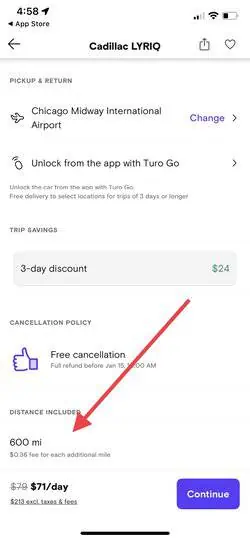Key Takeaways
- Turo sets default limits based on car value or location, with different limits for Deluxe and Super Deluxe class vehicles.
- Hosts can set their own limits, with options for daily, weekly, monthly, and unlimited distances.
- Hosts can charge for miles driven over the limit, calculated based on the vehicle’s daily rate.
- Keeping mileage within limits is crucial for meeting Turo’s vehicle condition requirements.
What are Turo Mileage Limits?
Turo mileage limits are driving-distance restrictions for vehicles rented on the platform, with options for daily, weekly, monthly, and unlimited distances.
These limits exist to control wear and tear on vehicles and maintain their condition as per Turo’s requirements. Hosts can set their own limits and charge for extra miles driven.

Many Turo hosts use unlimited mileage as a marketing tool, making listings more attractive to potential renters.
However, as a host, I would strongly consider weighing the pros and cons of increased rentals and the downsides like increase wear and tear on the vehicle.
How Are Mileage Limits Set on Turo?
Mileage limits occur in two ways:
- Turo sets them automatically
- Turo Hosts like you set custom limits
In either case, these restrictions deter Turo Guests from driving further than is listed when the vehicles enter their custody.
Turo reminds Guests about the distances they’re allowed to drive in a number of ways:
- Check Out: At check out (before confirming a booking), Turo displays the total distance for the trip.
- Trip Confirmation Email: Turo includes the allowed distance in the confirmation email it sends Guests after they book a trip.
- At Check-In: When Guests check in, Turo prompts them to record what the car’s odometer reads at the trip’s start and end.
- In-App Reminder: Turo displays the available miles (or kilometers) for a trip during check-in.
Finally, your Guests can see the distance when they click on the “Trips” tab and check the “Booked” section on their Turo account.
Related: Best Mileage Tracking Apps
Why Should You Care About Mileage Limits?
Turo has several eligibility requirements Host’s vehicles must meet if they’re to be accepted on the platform. In the U.S., the main ones that apply to this discussion include:
- Vehicle Registration and Location: The vehicle must be located in the U.S. and either registered to you or to an owner who authorized you to list it on Turo.
- Vehicle Age and Value: The car must be at most 12 years old (or younger) and have a fair market value of up to $200,000.
- Vehicle Condition: It has to have good mileage. Turo defines that as less than 130,000 miles.
Requirement three is why you should care about mileage limits. The farther Turo Guests drive your car, the more miles it racks up and mechanical wear and tear it incurs.
By association, the less likely it’ll be to meet Turo’s vehicle eligibility criteria. Therefore, if you want Turo to be lucrative for an extended time, you’ll need to keep an eye on how far Guests drive your car.
That said, Turo has stated on its website that “vehicles that reach or exceed 130,000 miles may remain listed.” The caveat is that they have to be “in excellent condition and continue to meet all legal, safety, and mechanical standards.”
Also, it isn’t clear how Turo verifies whether the vehicles on its platform have exceeded 130,000 miles. Still, it’s better to be safe than sorry.
Brett’s Take: Thoughts From an Expert
Many hosts view unlimited mileage as risky because renters may drive excessively, leading to increased wear and tear, maintenance costs, and decreased vehicle resale value.
I’ve noticed that unlimited mileage often attracts renters who plan on taking long trips, resulting in high mileage accumulation in a short period.
For example, I’ll specifically rent with Turo for this reason every time I visit Phoenix, Arizona. I rent a car from the Phoenix airport and then drive it to Sedona, Flagstaff, or even as far as the Grand Canyon.
If you’re a host, I would suggest setting unlimited mileage only on vehicles like non-Tesla EVs, where high mileage is less likely to actually be used due to charging constraints.
Types of Turo Mileage Limits
There are several types of mileage limits on the Turo platform, including:
Default Minimum Distance Limits
Turo sets minimum distance limits for all cars by default. The app bases your vehicle’s daily minimum distance limit on its value or location.
Turo Guests will see the daily distance limit for your vehicle when they open its listing. Depending on their location, they’ll see the figure represented as miles or kilometers.
The table below shows Turo’s minimum distance limits in the world regions it operates:
| Region | Limit |
| U.S. | 200 Miles |
| Canada | 300 Kilometers |
| UK | 200 Miles |
| Australia | 300 Kilometers |
| France | 200 Kilometers |
Vehicles that qualify as Deluxe Class or Super Deluxe Class have lower minimum distance limits than other vehicles on Turo.
The table below shows distance limits for both vehicle classes in their respective regions:
| Region | Deluxe Class Vehicle Limits | Super Deluxe Class Vehicle Limits |
| U.S. | 100 Miles | 75 Miles |
| Canada | 200 Kilometers | 100 Kilometers |
| UK | 200 Miles | 100 Miles |
| Australia | 200 Kilometers | 100 Kilometers |
We’ve excluded France from the above table because its distance limits remain the same irrespective of vehicle classes.
Weekly and Monthly Limits
You can also see your car’s weekly and monthly limits. Turo calculates these amounts by using the daily distance limit (whether it’s the default or a limit you set).
Therefore, if you set your vehicle’s daily limit as 200 miles, its weekly limit will be 1,400 miles.
Trip Extension Limits
Turo Guests may request trip extensions. As a Host, you have the liberty of granting or refusing these requests.
If you consent to a request, the Guest can drive further than the original daily distance limit you set without incurring charges. You can limit the additional miles or kilometers you granted over what was set in your original Turo listing.
Additional Distance Charges
Occasionally, a Guest may drive over the daily limit you set in your listing without making a trip extension request. Turo lets you charge them for the additional distance driven.
The platform calculates this cost by dividing your daily price and daily distance you listed. It gives you a percentage of the charge according to the protection plan you set for the trip.
Let’s say your vehicle gets booked for a two-day trip at $100 per day and 200 miles per day. Turo divides the trip’s overall price ($200 for the two days) by the total daily distance (400 miles). The additional distance fee will be $0.50 per mile.
Please note that you have 72 hours to request a reimbursement for the additional distance your Guest drives. This time limit begins to count from the time the trip ends.
Unlimited Distance
You can set distance limits as high as you like. The app also lets you get rid of distance limits altogether, in which case your Guests will have unlimited miles.
Where that’s the case, Turo will display a badge on your listing to indicate that it includes unlimited distance.
Final Thoughts
Turo’s distance limits are there to ensure that Guests don’t drive the vehicles on its platform farther than agreed. You can either set them yourself or use Turo’s default distance limits.
Either way, they can help your vehicle meet and stay within Turo’s eligibility requirements.
If a Guest exceeds the limit included in your listing, you can charge them for the additional miles driven.
You’ll need to act fast because you have a 72-hour window to make the reimbursement request. Your Guests may also request trip extensions, which you’re at liberty to grant or deny.






